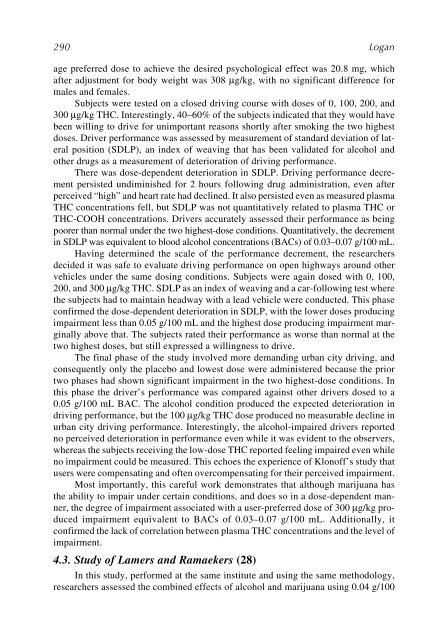Marijuana and the Cannabinoids
Marijuana and the Cannabinoids
Marijuana and the Cannabinoids
Create successful ePaper yourself
Turn your PDF publications into a flip-book with our unique Google optimized e-Paper software.
290 Logan<br />
age preferred dose to achieve <strong>the</strong> desired psychological effect was 20.8 mg, which<br />
after adjustment for body weight was 308 µg/kg, with no significant difference for<br />
males <strong>and</strong> females.<br />
Subjects were tested on a closed driving course with doses of 0, 100, 200, <strong>and</strong><br />
300 µg/kg THC. Interestingly, 40–60% of <strong>the</strong> subjects indicated that <strong>the</strong>y would have<br />
been willing to drive for unimportant reasons shortly after smoking <strong>the</strong> two highest<br />
doses. Driver performance was assessed by measurement of st<strong>and</strong>ard deviation of lateral<br />
position (SDLP), an index of weaving that has been validated for alcohol <strong>and</strong><br />
o<strong>the</strong>r drugs as a measurement of deterioration of driving performance.<br />
There was dose-dependent deterioration in SDLP. Driving performance decrement<br />
persisted undiminished for 2 hours following drug administration, even after<br />
perceived “high” <strong>and</strong> heart rate had declined. It also persisted even as measured plasma<br />
THC concentrations fell, but SDLP was not quantitatively related to plasma THC or<br />
THC-COOH concentrations. Drivers accurately assessed <strong>the</strong>ir performance as being<br />
poorer than normal under <strong>the</strong> two highest-dose conditions. Quantitatively, <strong>the</strong> decrement<br />
in SDLP was equivalent to blood alcohol concentrations (BACs) of 0.03–0.07 g/100 mL.<br />
Having determined <strong>the</strong> scale of <strong>the</strong> performance decrement, <strong>the</strong> researchers<br />
decided it was safe to evaluate driving performance on open highways around o<strong>the</strong>r<br />
vehicles under <strong>the</strong> same dosing conditions. Subjects were again dosed with 0, 100,<br />
200, <strong>and</strong> 300 µg/kg THC. SDLP as an index of weaving <strong>and</strong> a car-following test where<br />
<strong>the</strong> subjects had to maintain headway with a lead vehicle were conducted. This phase<br />
confirmed <strong>the</strong> dose-dependent deterioration in SDLP, with <strong>the</strong> lower doses producing<br />
impairment less than 0.05 g/100 mL <strong>and</strong> <strong>the</strong> highest dose producing impairment marginally<br />
above that. The subjects rated <strong>the</strong>ir performance as worse than normal at <strong>the</strong><br />
two highest doses, but still expressed a willingness to drive.<br />
The final phase of <strong>the</strong> study involved more dem<strong>and</strong>ing urban city driving, <strong>and</strong><br />
consequently only <strong>the</strong> placebo <strong>and</strong> lowest dose were administered because <strong>the</strong> prior<br />
two phases had shown significant impairment in <strong>the</strong> two highest-dose conditions. In<br />
this phase <strong>the</strong> driver’s performance was compared against o<strong>the</strong>r drivers dosed to a<br />
0.05 g/100 mL BAC. The alcohol condition produced <strong>the</strong> expected deterioration in<br />
driving performance, but <strong>the</strong> 100 µg/kg THC dose produced no measurable decline in<br />
urban city driving performance. Interestingly, <strong>the</strong> alcohol-impaired drivers reported<br />
no perceived deterioration in performance even while it was evident to <strong>the</strong> observers,<br />
whereas <strong>the</strong> subjects receiving <strong>the</strong> low-dose THC reported feeling impaired even while<br />
no impairment could be measured. This echoes <strong>the</strong> experience of Klonoff’s study that<br />
users were compensating <strong>and</strong> often overcompensating for <strong>the</strong>ir perceived impairment.<br />
Most importantly, this careful work demonstrates that although marijuana has<br />
<strong>the</strong> ability to impair under certain conditions, <strong>and</strong> does so in a dose-dependent manner,<br />
<strong>the</strong> degree of impairment associated with a user-preferred dose of 300 µg/kg produced<br />
impairment equivalent to BACs of 0.03–0.07 g/100 mL. Additionally, it<br />
confirmed <strong>the</strong> lack of correlation between plasma THC concentrations <strong>and</strong> <strong>the</strong> level of<br />
impairment.<br />
4.3. Study of Lamers <strong>and</strong> Ramaekers (28)<br />
In this study, performed at <strong>the</strong> same institute <strong>and</strong> using <strong>the</strong> same methodology,<br />
researchers assessed <strong>the</strong> combined effects of alcohol <strong>and</strong> marijuana using 0.04 g/100


